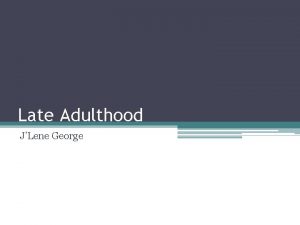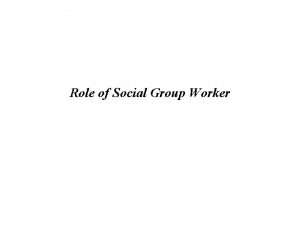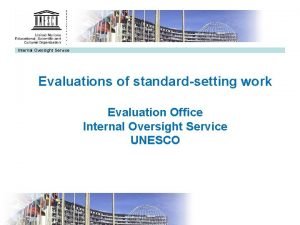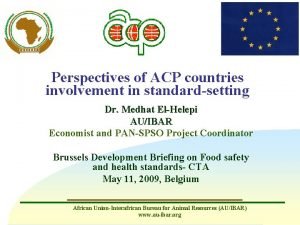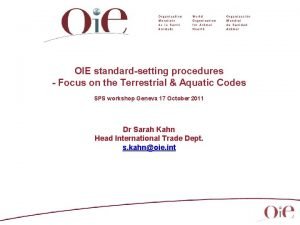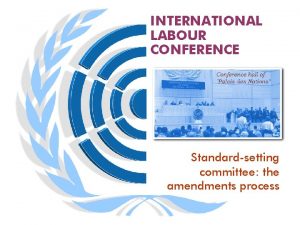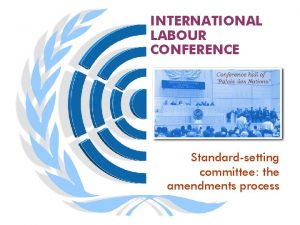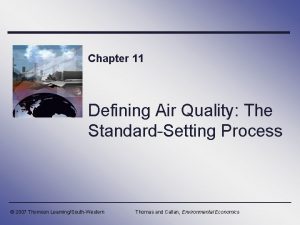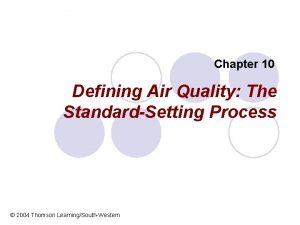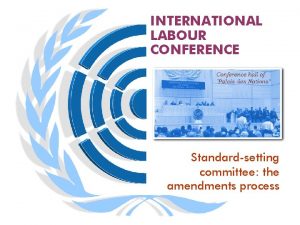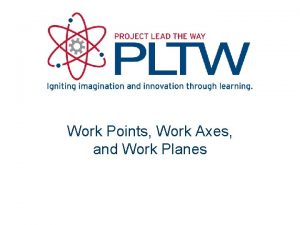Issues in Standardsetting work Workshop on the Role













- Slides: 13

Issues in Standard-setting work Workshop on the Role of International Standards in multilateral trade agreement, Geneva, 25 September 2006 Tadatsugu Toni Matsudaira World Customs Organization (WCO) 1

Topics n Definition n Standardization n “Representability” in standardsetting n How to increase the sponsors? 2

Definition -- WTO/TBT Agreement -Document approved by a recognized body, that provides, for common and repeated use, rules, guidelines or characteristics for products or related processes and production methods, with which compliance is not mandatory. It may also include or deal exclusively with terminology, symbols, packaging, marking or labelling requirements as they apply to a product, process or production method. (Annex 1 Paragraph 2) 3

Definition -- ISO/IEC Guide 2 -- “… The terms as defined in ISO/IEC Guide 2 cover products, processes and services. … Standards as defined by ISO/IEC Guide 2 may be mandatory or voluntary. ” (WTO Homepage) “ISO/IEC Guide 2” is available at ISO, charged at 154 Swiss Francs (CHF). 4

Definition -- WTO/TF negotiations -- (T)he term "international standards" shall be understood to refer [inter alia] to [a selection of] standards, guidelines and recommendations being parts of International Conventions or Agreements related to facilitating international trade and administered by relevant International intergovernmental organizations. (TN/TF/W/131) 5

WCO standards (examples) n HS Convention n WCO Data Model n Revised Kyoto Convention n Istanbul Convention n Immediate Release Guidelines n Time Release Study Guide 6

Standardization n In some cases, the sponsors are too few n Today’s 75% happiness vs tomorrow’s 100% happiness n Ownership of standards (the question of “representability” in standard-setting) n Needs to update vs implementation capacity n Insufficient capacity building 7

Sponsorship (mixed picture) Successful Developing countries n HS Convention (121) n Istanbul Convention (50) n Revised Kyoto Convention (50) 34% More efforts required 69% 42% + Not only the numbers but the balances of the members, e. g. , in terms of geography and/or level of developments are also important in order to establish international standards. 8

High Country Y’s welfare Low “You should change yours to mine” Low Country X’s welfare High Status quo International Standards based on X’s International Standards based on Y’s International Standards MRA (Situation can be not only cross countries but also cross sectors. ) 9

Participation 36% 56% 41% 69% 86% 74% All 6 regions’ participation is secured. Circle charts indicate the participation in the meetings (% to the total number of the WCO). Bar charts indicate the participation of developing countries (% to the total number of attending countries). 10

WCO standards evolution (not exhaustive) Harmonization of coding and data HS Convention (2007) Data Model Version 2. 0 (Guide) (2005) Data Model Version 1. 1 (Guide) (2003) Data Model Version 1. 0 (Guide) (2002) HS Convention (1996) Support tools for national TF initiatives AEO Guidelines (2006) Post-clearance audit Guidelines (2006) Diagnostic Framework* (Guide) (2003) ISCM Guidelines (2005) Resolution on UCR and Implementation Guide (2004) HS Convention (2002) Simplification and modernization of procedures Standardization of procedures ICT Guidelines (2004) Immediate Release Guidelines (2003) Risk Management Guide (2003) Recommendation on the use of WWW (1999) Time Release Study (Guide) (2003) Benchmarking Manual (Guide) (2003) Revised Kyoto Convention and its Guidelines(1999) Recommendation on Pre-entry classification (1996) Guidelines for Express Consignments Clearance (1993) Istanbul Convention (1990) HS Convention (1987) Kyoto Convention (1973) ATA Convention (1963) Convention establishing CCC (1950) *Diagnostic Framework is a living document and contains entire Customs themes, including 11 the TF

3 rd Generation: Use of international standards n -- TN/TF/W/131 -shall use relevant international standards or parts as a basis n in addition, are encouraged to use regional standards n exception with rationale that must be accountable (to explain why not use them) n are encouraged to take part in standard-setting and managing work n WCO is listed in the annex 12

For more information www. wcoomd. org www. gfptt. org e-mail: tadatsugu. matsudaira@wcoomd. org 13
 Worker role azure
Worker role azure Role taking krappmann
Role taking krappmann Statuses and their related roles determine
Statuses and their related roles determine Ego differentiation versus work-role preoccupation
Ego differentiation versus work-role preoccupation Enabler role in social work
Enabler role in social work Hình ảnh bộ gõ cơ thể búng tay
Hình ảnh bộ gõ cơ thể búng tay Bổ thể
Bổ thể Tỉ lệ cơ thể trẻ em
Tỉ lệ cơ thể trẻ em Voi kéo gỗ như thế nào
Voi kéo gỗ như thế nào Chụp tư thế worms-breton
Chụp tư thế worms-breton Alleluia hat len nguoi oi
Alleluia hat len nguoi oi Môn thể thao bắt đầu bằng chữ f
Môn thể thao bắt đầu bằng chữ f Thế nào là hệ số cao nhất
Thế nào là hệ số cao nhất



